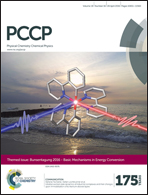A theoretical study of nitric oxide adsorption and dissociation on copper-exchanged zeolites SSZ-13 and SAPO-34: the impact of framework acid–base properties†
Abstract
The adsorption of nitric oxide as dinitrosyls and the deNOx proton-mediated reaction mechanism are assessed using electronic structure methods and transition state theory. Dinitrosyls bind to copper cations either via a N-atom or via an O-atom, with N-binding being more stable. In their ground states, dinitrosyls reach a planar configuration with the metal cation. The two nitric oxide molecules are kept together in O-bonded dinitrosyls by the N–N bond and the adsorption complex obtains a cyclic planar structure, while N-bonded dinitrosyls have out-of-plane conformations with low energy barriers. An asymmetric structure ZCu(ON)(NO) with one N-bonded nitrosyl and the other O-bonded is of the lowest stability. The cyclic hyponitrite ZCu(ON)2 adsorption complex undergoes O–N bond breaking upon protonation of one oxygen atom and this lowers the energy barrier of the first reaction step of nitric oxide dissociation to yield N2O and a hydroxylated copper site ZCu(OH) by 45 kJ mol−1 for Cu-SAPO-34 and by 46 kJ mol−1 for Cu-SSZ-13. The more stable N-bonded dinitrosyl ZCu(NO)2 provides less favorable reaction which passes through the asymmetric ZCu(ON)(NO) intermediate structure. Brønsted acid sites facilitate the reversal of one nitrosyl group. The role of proton transfer from a Brønsted acid site to dinitrosyls is not limited to the initial step of facilitating the N–O bond cleavage, but it also contributes to the stabilization of intermediate oxygen species formed at the copper site as hydroxide ZCu(OH) and hydroperoxide, ZCuOOH. Without protonation, the unstable ZCuO intermediate causes structural deformation with strongly lengthened T–O bonds in the framework. The rate determining step is N2O decomposition to N2 and O2, whether starting with a ZCu(NO)2 or a ZCu(ON)2 adsorption complex, and Cu-SSZ-13 has a clear advantage with an energy barrier of 195 kJ mol−1vs. 265 kJ mol−1 for Cu-SAPO-34. In the final step the Brønsted acid site is restored by proton transfer from the hydroperoxide ZCuOOH to the framework and molecular oxygen is released. The overall energy barrier for the proton-assisted reaction of ZCu(ON)2 decomposition for Cu-SSZ-13 is by 48 kJ mol−1 lower than the barrier of the proton-free pathway.


 Please wait while we load your content...
Please wait while we load your content...